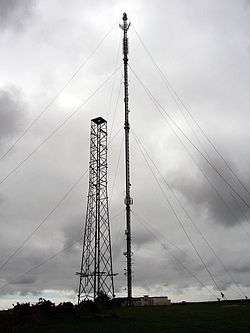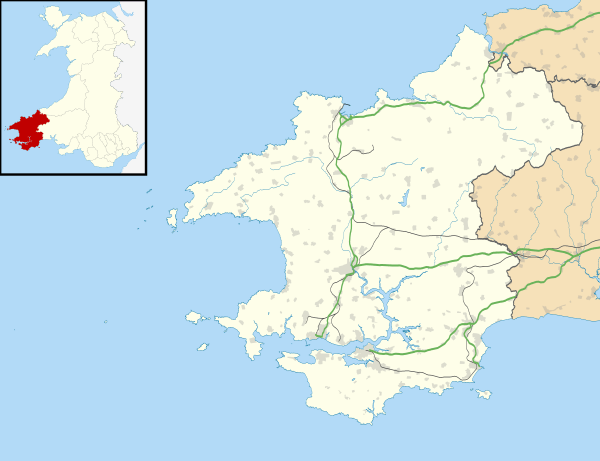Haverfordwest transmitting station
The Haverfordwest transmitting station is a broadcasting and telecommunications facility located at Woodstock about 13 km (8 mi) to the north east of the town of Haverfordwest, in Pembrokeshire, Wales (grid reference SN028261). It was originally built by the BBC, entering service in early 1964 acting as a main transmitter for the 405-line VHF television system, and as a repeater for Band 2 VHF FM radio received off-air from Blaenplwyf transmitting station.[1] It is now owned and operated by Arqiva.
 | |
 Haverfordwest Preseli | |
| Mast height | 154.4 metres (507 ft) |
|---|---|
| Coordinates | 51°53′57″N 4°51′59″W |
| Grid reference | SN028261 |
| Relay of | Preseli |
| BBC region | BBC Wales |
| ITV region | ITV Wales |
The site has a 155 m (509 ft) guyed steel lattice mast erected on land that is itself about 187 m (614 ft) above sea level. The radio broadcasts cover the majority of Pembrokeshire, except the north eastern part of the county. The signals also can reach the outskirts of Cardiff and the Vale of Glamorgan.
It currently carries seven analogue FM radio stations, including BBC Radio 1, BBC Radio 2, BBC Radio 3, BBC Radio 4, BBC Radio Cymru, BBC Radio Wales and Radio Pembrokeshire.
When UHF analogue television was added in 1990,[2] those services were provided only at very low power and only designed to cover the small villages of Puncheston, Castlebythe, Little Newcastle and Rosebush, which are all located within about 7 km (4 mi) of the mast.
It currently carries three digital television multiplexes at twice the ERP of the analogue services that they replaced, thus providing digital TV to a much larger area than had been served before.
The mast had its aircraft warning lights upgraded in October 2006, from white xenon discharge flashers to red lamps employing arrays of ultrabright LEDs.
Services listed by frequency
Analogue television
17 February 1964 - January 1985
| Frequency | VHF | kW | Service |
|---|---|---|---|
| 61.75 MHz | 4 | 10 | BBC1 Wales |
January 1985 - 18 July 1990
The 405-line VHF television system closed down permanently across the UK, and from then until Summer 1990, the site transmitted no television signals, just VHF radio.
18 July 1990 - 19 August 2009
Colour TV was added very late: Haverfordwest became a UHF relay of Preseli. Being in Wales, this transmitter radiated the S4C variant of Channel 4.
| Frequency | VHF | UHF | kW | Service |
|---|---|---|---|---|
| 719.25 MHz | — | 52 | 0.05 | BBC1 Wales |
| 751.25 MHz | — | 56 | 0.05 | HTV Wales |
| 831.25 MHz | — | 66 | 0.05 | BBC2 Wales |
| 847.25 MHz | — | 68 | 0.05 | S4C |
Analogue and digital television
19 August 2009 - 16 September 2009
Digital Switchover started at Haverfordwest, mirroring the changes at its parent transmitter at Preseli. BBC Two closed on channel 66 and ITV1 Wales switched to that channel for its final three weeks of service. The BBC multiplex A started up on channel 56 vacated by ITV.
| Frequency | UHF | kW | Service | System |
|---|---|---|---|---|
| 719.25 MHz | 52 | 0.05 | BBC One Wales | PAL System I |
| 754.000 MHz | 56 | 0.1 | BBC A | DVB-T |
| 831.25 MHz | 66 | 0.05 | ITV1 Wales | PAL System I |
| 847.25 MHz | 68 | 0.05 | S4C | PAL System I |
Digital television
16 September 2009 - 31 October 2012
All the remaining analogue TV services closed and were replaced with the standard three multiplexes of Freeview Lite. Notice that unusually, the digital TV services are broadcast at twice the ERP that had been provided in the analogue TV days. At most sites, the digital services are broadcast at a fifth the ERP of the old analogue channels.
| Frequency | UHF | kW[3] | Operator |
|---|---|---|---|
| 690.000 MHz | 48 | 0.1 | BBC B |
| 722.000 MHz | 52 | 0.1 | Digital 3&4 |
| 754.000 MHz | 56 | 0.1 | BBC A |
31 October 2012 - present
As a side-effect of frequency-changes elsewhere in the region to do with clearance of the 800 MHz band for 4G mobile phone use,[4] Haverfordwest's "BBC B" multiplex was moved from channel 48 to channel 47. Additionally, all the transmissions at the site gained a +3 dB power boost.[5]
| Frequency | UHF | kW[6] | Operator |
|---|---|---|---|
| 682.000 MHz | 47 | 0.2 | BBC B |
| 722.000 MHz | 52 | 0.2 | Digital 3&4 |
| 754.000 MHz | 56 | 0.2 | BBC A |
Analogue radio (FM VHF)
| Frequency | kW[7] | Service |
|---|---|---|
| 89.3 MHz | 20 | BBC Radio 2 |
| 91.5 MHz | 20 | BBC Radio 3 |
| 93.7 MHz | 20 | BBC Radio Cymru |
| 95.9 MHz | 20 | BBC Radio Wales |
| 98.9 MHz | 20 | BBC Radio 1 |
| 102.5 MHz | 20 | Radio Pembrokeshire |
| 104.9 MHz | 20 | BBC Radio 4 |
See also
- List of masts
- List of radio stations in the United Kingdom
- List of tallest buildings and structures in Great Britain
References
- http://downloads.bbc.co.uk/rd/pubs/reports/1964-22.pdf
- http://www.bbceng.info/Information/eid/press-releases/Transmitter_Press_Releases_07Oct1991_to_18July1990.pdf
- Television Viewers Guide 2009
- Summers, Nick (2012-02-15). "EU States Must Allow 4G on Analogue TV Spectrum". Thenextweb.com. Retrieved 2013-05-28.
- "4G clearance retunes". a516digital. Retrieved 2013-05-28.
- Television Viewers Guide 2009
- Radio Listeners Guide 2010